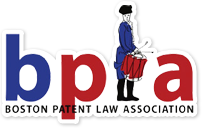
President's Message
By
Monica Grewal
,
WilmerHale

Since the first newsletter in February, the last couple months have flown by with much happening in our Boston Patent Law Association community as well as in the national IP community.
Our 25 Committees, thanks to President Elect Rory Pheiffer, have successfully convened several meetings and socials to get their constituent members discussing their committee agendas, and have already delivered results from these collective planning exercises in the form of more relevant and robust programming for the BPLA membership. Rory’s report in this newsletter regarding the events hosted to date provides the details of the BPLA’s educational programming. I was pleased to attend the first BPLA Case Law Committee meeting regarding some of the more contentious rules adopted by the Patent Trial and Appeal Board (PTAB) that concern the burdens placed on patent owners in AIA post-grant proceedings. A panel decision by the U.S. Court of Appeals for the Federal Circuit (CAFC) in May 2016, In Re Aqua Products, originally appeared to have confirmed that the PTAB’s rules regarding amended claims are proper. However, on August 12th, the full Court vacated the earlier decision and granted rehearing en banc. The discussion at the Case Law meeting revolved around the Court ordered supplemental briefing and argument on the following issues: (a) When a patent owner moves to amend its claims under 35 U.S.C. § 316(d), may the United States Patent and Trademark Office (USPTO) require the patent owner to bear the burden of persuasion, or a burden of production, regarding patentability of the amended claims as a condition of allowing them? Which burdens are permitted under 35 U.S.C. § 316(e)?
(b) When the petitioner does not challenge the patentability of a proposed amended claim, or the Board thinks the challenge is inadequate, may the Board sua sponte raise patentability challenges to such a claim? If so, where would the burden of persuasion, or a burden of production, lie?
The ability to amend patent claims is often critically important to patent owners – but any shift in the burden of proof to the petitioner is expected to make post-grant reviews more difficult for patent challengers. I share this exemplar detail discussed at our Case Law Committee meetings to encourage our members to join in these open forum discussions regarding the recent decisions that keep us all in the know.
Our agenda to cement the pathways between the BPLA and the USPTO has been well served already by at least the January visit by Trademark Trial Appeal Board’s (TTAB) Chief Judge Gerald F. Rogers who educated our members as to the recent rule changes, the April joint visit of the Judges from the TTAB and Patent Trial and Appeal Board (PTAB) who sat in session at Suffolk University Law School as well as a joint program with the Federal Circuit Bar Association Bench & Bar and the BPLA regarding the evolution of patent litigation that included Judges from our District of Massachusetts, the PTAB and the Federal Circuit Court of Appeals and was moderated by our immediate Past President, Erik Belt.
At the national level, the PTAB Bar Association hosted its Inaugural Conference in Washington DC on March 1st – 3rd. (
PTAB Bar Conference
) It was a gathering that brought PTAB practitioners together with the PTAB Judges, Industry members, Judges from District Courts and the International Trade Commission (ITC) to discuss the impact of the decisions of the PTAB, appeals therefrom, interplay with patent litigation and the procedural postures in all these venues due to the Post Grant Procedures. It was both exciting and humbling to moderate a panel entitled “Complex Issues in PTAB Practice” that focused on motions to amend, joinder and consolidation, and requests for rehearing. I encourage our members to consider participating in these national Bar Association efforts as it is both gratifying to be a part of the camaraderie in our profession as well as having the benefit of enhancing our practice given that Post Grant Procedures have impacted both the litigation and prosecution of the patents in our individual practice areas. Chief Judge David Ruschke of the PTAB provided the keynote address early in the conference and provided statistics that documented the success and the popularity of the Post Grant Proceedings. A link to these statistics that illustrates the popularity and impact of these proceedings can be found here
:
35 U.S.C. Section 101 and potential legislative solutions has been very much in the news as well. I had the pleasure of attending and discussing the problems and potential “cures” to the Alice tests at a President’s Forum hosted by the NYIPLA and moderated by David Kappos, who served as the Under Secretary of Commerce for Intellectual Property and Director of the United States Patent and Trademark Office from 2009 to 2013. Representatives of the National Bar Associations of the IPO, AIPLA and the ABA attended the closed door Chatham style forum. Drawing from the BPLA’s rich history of providing comments to the USPTO Section 101 initiatives and guidelines, our articles and even member Amicus Briefs, and with the support of the Patent Law Committee, the BPLA contributed to the discussion as documented in a report by Jonathan Roses in this edition of the newsletter. The report provides a timeline and summary of the evolution of the case law with respect to subject matter patentability that is a useful resource to understanding the issues being discussed with respect to the two-step inquiry of the Alice test. A couple of photographs from the Presidents forum are below.

Section 101 is a perfect segue to share one of my most memorable moments of this year with respect to the BPLA: a phone conversation with one of BPLA’s Past Presidents:
Faith Driscoll
, who was the first woman President of the BPLA in the 1984-85 time period. Ms. Driscoll shared some fascinating information as to her involvement in the development of the jurisprudence of 35 U.S.C. Section 101 as she wrote much of the Respondent’s brief in the case Diamond v. Franklin. She is listed as Of Counsel in the Supreme Court decision as she was working as an in-house Patent Counsel at Honeywell Systems. The 1980 brief in the Diamond v. Franklin, Supreme Court Docket No. 79-855,1980 Oct. 1980 (for JOHN J. BRADLEY AND BENJAMIN S. FRANKLIN, Respondents) that informed the Diamond v. Diehr case is a fascinating read and can be accessed here
and here
Ms. Driscoll shared that much like in the 1980 time frame when she was drafting the1980 briefing in the Franklin/Bradley case she believes there is no need to amend 35 U.S.C. Section 101. She shared that the law of patentability is being informed by poorly drafted invention disclosures, specifications and equally poorly drafted claims. She shared that it is improper to rely on Section 101 to discern what is new and what is old: that rests in the inquiry related to the later sections in the statute, 35 U.S.C. sections 102 and 103. She reminded us that the Diamond v. Diehr case explicitly forbade us to apply the queries that relate to the later parts of the statute to Section 101 queries. Her analysis of Section 101, consistent with the statute, centers around understanding and showing how the idea has been applied. With the right level of details one should for example, take a law of nature and fully and thoroughly apply it so that the specification and claims are no longer about the law of nature but about the application. One has then passed a gate check to be able to proceed to sections 102 and 103. Her recall of the early cases and the impact of their decisions in developing Section 101 jurisprudence was amazingly relevant more than three decades later and left me wondering that we would all benefit from reviewing the earlier decisions and precedents to get our arms around Section 101.
By today’s standard, Ms. Driscoll came to patent law via a very different path. She began her education by deciding to go into the Navy and enlisted and trained to become an aviation electronics technician. Ms. Driscoll went on to work as an electronics technician with responsibilities that included working in an air control tower and being in charge of ground electronics. Ms. Driscoll surmised that the U.S. government jobs provided more responsibility to a woman as compared to jobs in the private sector. This may explain why more women started working in the engineering field by launching their careers in the government. Ms. Driscoll had also observed that many women began their patent careers by first taking jobs at the USPTO. She left the Navy to go to school by taking an early release and enrolling in the Electrical Engineering curriculum at Northeastern University which she remembers fondly. As part of her Co-op opportunity at Northeastern University in Boston she explored an in-house work position at GTE Sylvania that provided a glimpse into the life and work expectations of a patent lawyer. Having done well in her undergraduate degree, Ms. Driscoll then embarked into her legal studies at Suffolk Law School in Boston and sought out the same good professors one of her good friend recommended. This friend was a patent attorney working in-house at a corporation who further reinforced for Ms. Driscoll that it would be advantageous to explore an in-house patent position.
Ms. Driscoll joined the patent department at Honeywell Information Systems, MA and worked on numerous patents in the computer and semiconductor field. She recalls many anecdotes such as how Sperry Corporation was asserting their basic patents related to the Univac computer which led to her working with attorneys from the law firm of Cesari & McKenna for a reexamination.
Ms. Driscoll recalled some of the high points of her patent law career related to her getting involved at Honeywell with drafting a number of patents, as well as a printer case at Honeywell and her work with a Minnesota based law firm. This printer case dealt with an inventorship dispute centered around an inventor whose invention during his student years became the basis of a law suit of a later invention. Ms. Driscoll retired out of Honeywell.
I will now let you all enjoy the articles and reports in this edition of our newsletter with the hope that you all come and enjoy the BPLA’s signature annual event on May 12th at the Moakley Courthouse – our Judges Dinner – that will honor Retired Federal Circuit Judge Arthur J.Gajarsa. The evening promises to be memorable with Chief Judge Prost of the CAFC attending with Judges Lourie, Clevenger and O’Malley of the CAFC; Chief Judge David Ruschke of the PTAB, many of a Judge Gajarsa’s clerks including Paul Grewal, Joe Cianfrani, as well as the Boston contingent of Judge Gajarsa’s clerks, that include Gregory Corbett, Nathan Speed, and Lawrence Cogswell.








